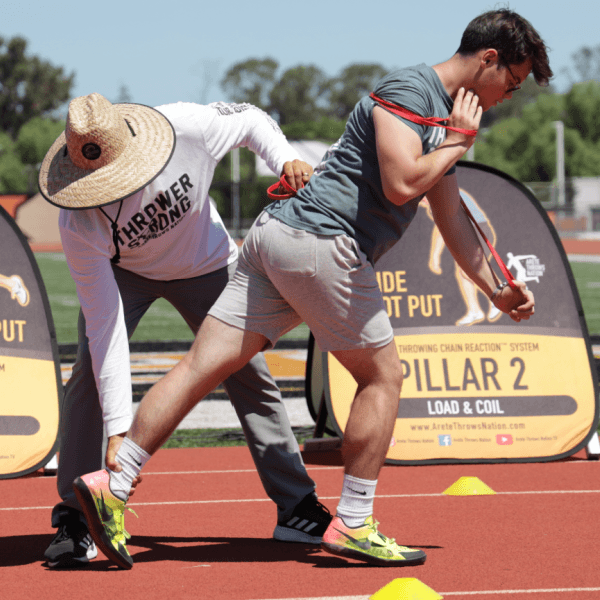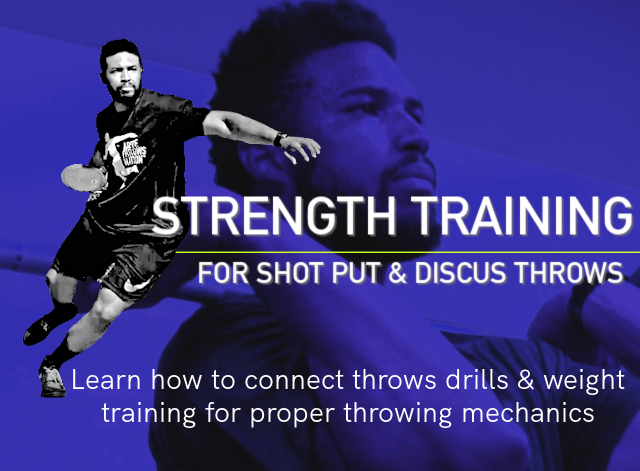WINTER THROWS TRAINING
strength training & throwing technique
At this time of year- starting in October to February- you’re winter throws training is going to focus on breaking down technique and clean it up for a strong track season.
If you throw, throw, throw and constantly throw, there’s clearly a lot of benefit to that, but you need to be working on drills for the various parts of the throw.
For example, every thrower should be drilling
- Left and right leg axis,
- Separation,
- Power position,
- The left arm and left leg block,
- And delivery
of the shot put and discus throws.
The Arete Throws Club,
here in Phoenix, AZ, starts back up in October. At this time we begin taking the drills work into the ring two days a week. We work on a lot of stand throw mechanics -power position, right leg axis and block- concentrating on the right leg axis, and timing of the block.
In addition to that, this is the time to work on the modified wheel drill to work the right left axis and 45-degree angle to work rotation of the power position.
In the shot put and the discus throw, the key focus will be at perfecting Pillar 1 – The Wind-up.
Pillar 1 drills address balance in the back of the ring (balance left to right) and balance in the middle of the throw (balance front to back).
Whether you’re an in-coming freshmen, or an elite thrower, you should be spending this time learning the throw and breaking down the technique
Winter throws training focus is about technical positions, and working on any technical errors that need to be improved before the next season arrives.
Winter throws training is a time to focus on the parts of the throw.
It’s also time to work on
- Strength and size development- getting bigger, stronger, and faster movement
- Building strength levels in areas where the athlete’s weakness is effecting their ability to do drills correctly
- Working on flexibility and core strength in order to train separation and rotation
- Get on a performance nutrition plan… eating right to support the weight training & throws programs.
- Incorporating postural work and recovery protocols post strength training sessions.
It all ties together.
TCR COACHING NOTE* – Weight training should be focused on making you a better thrower, not just better in the weight room. Your numbers in the weight room must relate to what is going on in the ring- functional strength training, not strong man training. Click here to learn about our online course- Strength Training for Throwers
Even though weight training is a big part of your training, avoid over training, so that:
- You’re not getting burned out half way through the track season
- You’re enjoying the process and having fun.
It’s building a sense of anticipation for the next year.
Ultimately, throwers must have a strong understanding of the science of the throw
the TCR® system delivers for any throws program looking for real results- fast!
Around this time of year, coaches will ask me, “What percentage of your training focuses on the throwing?”
In the fall/ winter training,
- 2 days throwing and always focusing on technique, making proper adjustments
- 3 days a week in the weight room- here we combine a strength training program and specific throws work
In the fall/ winter training, it is also a time when we host TCR throws camps across the country>> click here to see more on TCR Throws Camps
This is a great way learn the TCR® system & launch your throws season in the right direction!
In conclusion, winter throws training has 2 main focus points: Strength levels and correcting any incorrect throws technique.
Drills are the lifeblood to any throws training program.
It’s also the best way to get a lot of repetition in a short amount of time.
I’ve had athletes at the high school level spend 45 minutes to an hour, getting 150 repetitions in; that’s throwing over and over and over- It’s the fastest way to break bad habits.
Then design & execute a solid strength training program. You can’t compete in any throwing event if your strength levels are optimal.
For more info & programs offered, see below
Until next time,
Coach Johnson







